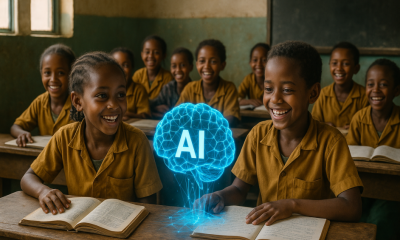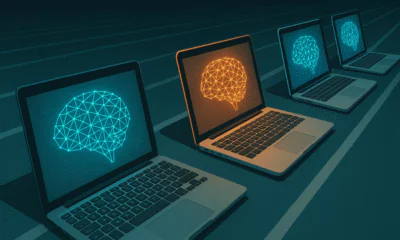Thought Leaders
How AI Helps With Education Automation And Management

Let's take a moment to travel back in time and think of a classroom from a few decades ago: the unmistakable screech of chalk on the blackboard, students hastily scribbling notes from bulky textbooks, and teachers relying on the age-old method of “repeat after me.” The teacher was the sole source of information and teaching aids were limited to physical objects like maps, globes, and perhaps an overhead projector.
Today we see the hum of computers, the glow of smartboards, and the almost magical ability to pull up information from the Internet in real time. The essence of education remains – imparting knowledge and fostering growth. However, the methods, the efficiency, and the precision evolve. The once-clear lines between human tasks and machine tasks blur. This transformation revolutionizes how we think about education and classroom management.
Streamlining Classroom Processes With AI and Automation
AI has come a long way. In recent years, this technological marvel has found a significant place in the sphere of education. Why bring automation into classrooms? The primary objective is simple: to relieve educators from mundane, repetitive tasks so that they can focus more on what they do best – teaching and nurturing young minds.
Let's delve deeper into how AI and automation are revolutionizing classroom processes:
- Digital Attendance Systems
Gone are the days of calling out each student's name. With automated attendance systems, students can swipe their ID cards or facial recognition software can identify them, making the process quicker.
- Intelligent Scheduling
An AI system can optimize schedules, ensuring that classrooms, labs, or libraries do not clash, are efficiently utilized based on class size, and students get the time slots that best suit them.
- Real-Time Grading and Feedback on Assignments
AI can instantly assess student submissions, highlighting areas of concern and offering feedback, allowing educators to intervene promptly when a student seems to be struggling. The feedback provided could be similar to that of an original essay writer giving critiques, ensuring clarity and coherence in students' submissions.
- Predictive Analysis for Student Performance
By analyzing data, AI can predict which students are at risk, allowing for timely interventions.
- Notifications and Alerts
Teachers and students no longer need to rely on manual announcements or notice boards. Automation tools can send out notifications regarding upcoming tests, assignment deadlines, or school events directly to students' and parents' phones or emails.
- Feedback Collection
Collecting feedback about courses or teaching methods can now be automated with digital surveys. This not only simplifies the collection process but also makes data analysis faster and more accurate.
- Automated Exam Proctoring
To combat the challenges of cheating in online exams, many institutions can employ automated proctoring software. These tools monitor students through their webcams during the test. Using AI, the software can flag suspicious movements or activities, such as a student looking away from their screen frequently or someone else entering the room.
- Real-time Language Translation
In a diverse classroom with students from various linguistic backgrounds, as a teacher delivers a lecture in English, AI-driven tools can simultaneously transcribe and translate the content into multiple languages.
The Bigger Picture: Enhancing the Learning Experience
The rise of AI in classroom automation is about creating a richer, more personalized, and efficient learning environment. Beyond direct classroom applications, it plays a role in the broader educational ecosystem. For example:
- Cameras equipped with AI can monitor school premises. While automation manages data storage and access protocols, AI can detect unusual activities or unauthorized access, sending instant alerts. It can even notify the janitorial staff about detected spills, helping prevent children from slipping and getting injured.
- Intelligent systems connected to school buses equipped with GPS can automatically notify parents of their child's arrival time.
- Cafeterias, labs, and libraries can use automated systems to track inventory.
- School administrations can automate billing and fee collections, ensuring timely payments without the manual hassle.
It is essential to approach any tech with a balanced perspective. While AI and automation offer numerous advantages, there are challenges to consider. Schools need to ensure that the technology they adopt is user-friendly and does not become an additional burden for educators. Privacy and data security are paramount, especially when dealing with students' personal information.
The Role of Educators in an AI World
With AI becoming increasingly prevalent, one might wonder: “Where does this leave our educators?” It is a legitimate concern, but rest assured, the essence of teaching is not being sidelined. At the heart of education lies the bond between students and teachers – a bond that technology can augment but never replace.
Rather than acting as a competitor, AI serves as an ally to educators, reshapes their role for the better, and amplifies their importance in several ways.
Mentioned above AI grading systems provide teachers with instant results, allowing them to use that saved time to engage in one-on-one discussions with students, delving deeper into topics of interest.
While AI provides data and information, educators play the crucial role of encouraging students to think critically, ask questions, and connect the dots. Teachers not only discuss poetry or history but also life lessons, values, and ethics – areas where human interaction is irreplaceable. They guide students in interpreting texts in the context of the world around them.
While employing collaborative tools in the classroom, where students work in groups on projects, AI manages team assignments, resource allocation, and progress tracking, allowing teachers to foster teamwork, leadership, and interpersonal skills among students.
Preparing for an AI-Driven Schools
The introduction of sophisticated technology demands more than just implementation; it requires careful preparation. For AI to genuinely benefit the classroom, educators and students alike must adapt and evolve. There is an undeniable need for adequate training to harness AI potential fully.
- Educator Workshops on AI Tools
It is good that before the start of the academic year, teachers attend a week-long workshop on the new AI-driven learning systems being introduced. They should learn how to navigate the platforms, understand features, and discover ways to integrate them seamlessly into their teaching methods.
- Student Onboarding Sessions
Before introducing new tools, such as an AI-based writing and research assistant, students should be taught how to formulate queries, interpret results, and utilize the tool for assignments through hands-on sessions.
- Understanding AI's Capabilities and Limitations
When using AI for grammar checks, teachers should emphasize to students that while the tool can catch mechanical errors, it may not always grasp the nuances of tone or style. Thus, teachers should encourage students to use the tool as a preliminary check but to rely on their judgment for the final touch. Setting the right expectations ensures that AI is seen as a tool for enhancement, not a magic wand.
- Educating About Ethical Use
Teachers should conduct sessions on the responsible use of AI tools, emphasizing the importance of not manipulating algorithms for unfair advantages or using tools for plagiarism, etc.
Conclusion
The world of education is undergoing a significant transformation. Embracing AI and automation is not just an option; it is the future. The transition to an AI-driven classroom is not merely about introducing new tools but about shifting the educational paradigm. It is about ensuring that the human touch in education is amplified by technology, not overshadowed.












